
"*" indicates required fields
"*" indicates required fields
"*" indicates required fields

November trends aligned with typical seasonality, with increased tightness observed around Thanksgiving. While the peak season was relatively muted for van, reefer saw tighter conditions than in Q4 2022, indicating that the reefer market recovery remains well ahead of van.
We expect to see similar conditions around Christmas and New Year’s. However, the market should loosen again in mid-January, as usual. The Fed may cut interest rates as inflation continues to cool during the first half of 2024, which could catalyze increased demand.
Holiday demand picked up before Thanksgiving, resulting in tighter conditions.
Tender rejection activity below 4% for van equipment illustrates historically strong contract compliance and carriers’ continued appetite for accepting nearly all contract freight.
Elevated tender rejection rates indicate the recovery may be further along for reefer equipment than van and that the market may be more vulnerable to seasonal demand surges later in the quarter.
Large numbers of authority revocations continue; there has been a negative net change in the carrier population in 13 of the last 14 months as exits outpace new entrants.
New Class 8 truck orders remain high as 2024 build slots open, indicating capacity is exiting the market more slowly than previously estimated, which could push the rate recovery deeper into 2024.
The National Retail Federation reported strong import numbers over the last quarter of 2023, indicating that the destocking phase is ending for many retailers.
Inflation remains below 4%; the Fed kept interest rates flat for another month and will likely start to decrease rates sometime after Q1 of 2024.
Carriers with contractual freight are relatively stable, adding drivers and investing in new equipment.
What’s Happening: There was volatility and tighter conditions around the Thanksgiving holiday.
Why It Matters: Conditions confirmed that the Reefer recovery is going strong, while the van market is lagging.
The Morgan Stanley Dry Van Freight Index is another measure of relative supply; the higher the index, the tighter the market conditions. The black line with triangle markers on the chart provides a great view of what directional trends would be in line with normal seasonality based on historical data dating back to 2007.
Conditions were relatively stable throughout the first half of November before ticking up in the second half. This was in line with seasonal directional trends but remains below the 10-year average, indicating that supply is still largely sufficient to support current demand.
Figure 1: Morgan Stanley Dry Van Truckload Freight Index

In October, Arrive launched a new survey designed to help our team better understand the carrier experience in today’s market. The questions gauged carriers’ sentiment on various economic indicators and asked for their predictions on how the next 90 days will unfold. When questioned about the state of the market, over 50% of respondents reported that current conditions are relatively loose, and 25% said they are tight or very tight.
Those results changed when looking 90 days down the road — the consensus was market conditions would either look much like they do today or slightly tighter. 40% of respondents believe conditions will still be loose, and over a quarter say we will be experiencing intermediate conditions. 21% of respondents believe we will be in a tight market, while 12% expect very tight conditions.

According to ACT’s Supply-Demand Index, conditions have tightened for three consecutive months after being loose for the previous 17 months. The most recent reading was down slightly to 52.4 from 52.8 in September, primarily caused by steady freight demand and capacity exiting the market. It’s important to note that this is only a directional measure, and the overall state of the market remains soft.
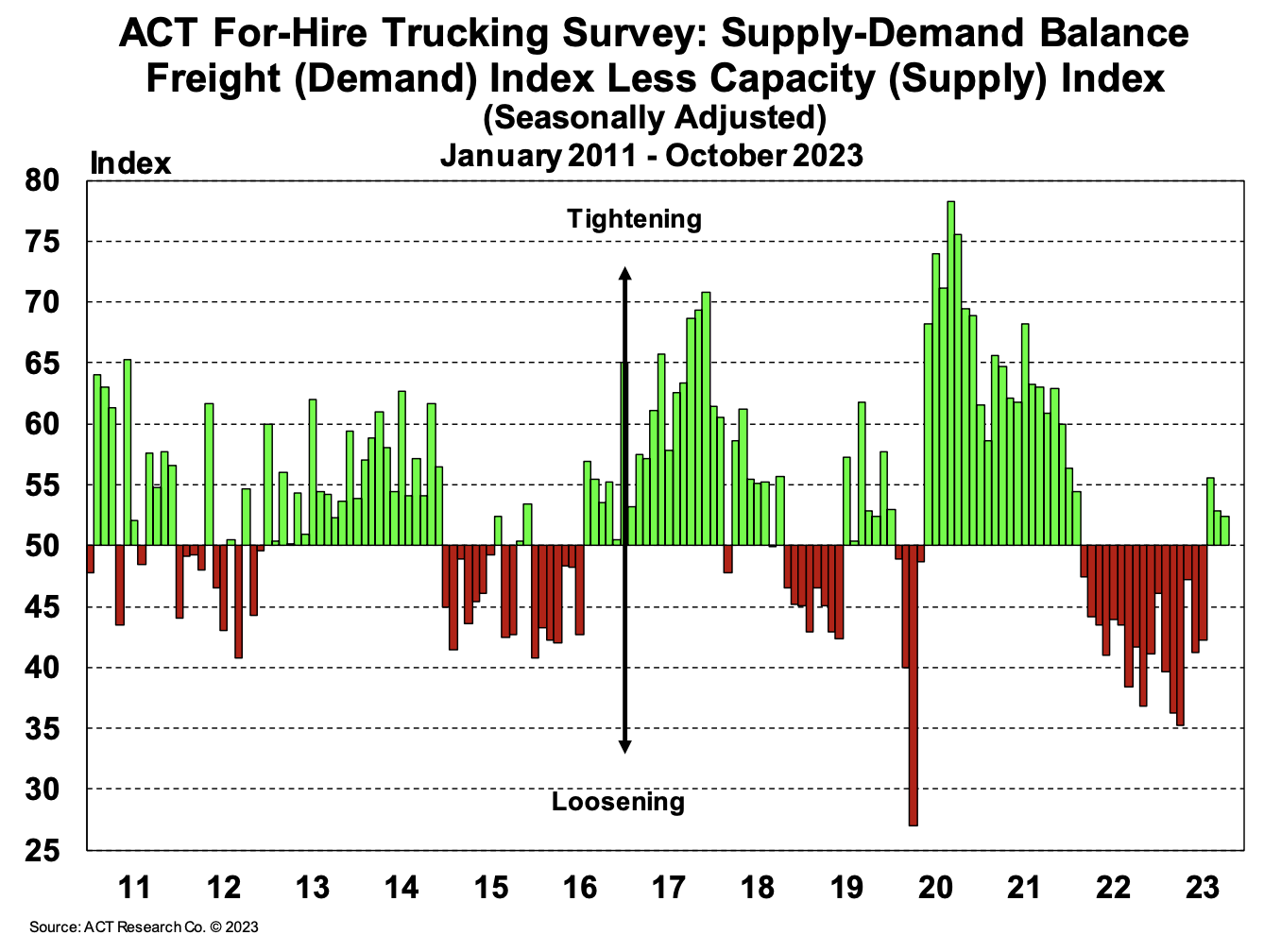
This holiday season indicates there is sufficient capacity to meet the demand. While there was some tightness around Thanksgiving, it was not as severe as in previous peak seasons. However, regional demand surges may lead to tighter conditions as we approach Christmas and New Year’s. By mid-January, conditions are expected to loosen as demand slows down and drivers return from time off.
Nationally, the dry van side shows softer conditions relative to the past five years. The reefer side saw a tender rejection spike in late November but has since declined after Thanksgiving. Reefer conditions remain relatively loose, though not as loose as last year.
The Sonar Outbound Tender Reject Index (OTRI) measures the rate at which carriers reject freight they are contractually required to take. The index briefly reached 4% around Thanksgiving before dropping below that mark, indicating that shippers’ compliance with routing guides on contractual freight is improving from already high levels. We anticipate some tightening as we approach the second half of the month and enter January of next year.
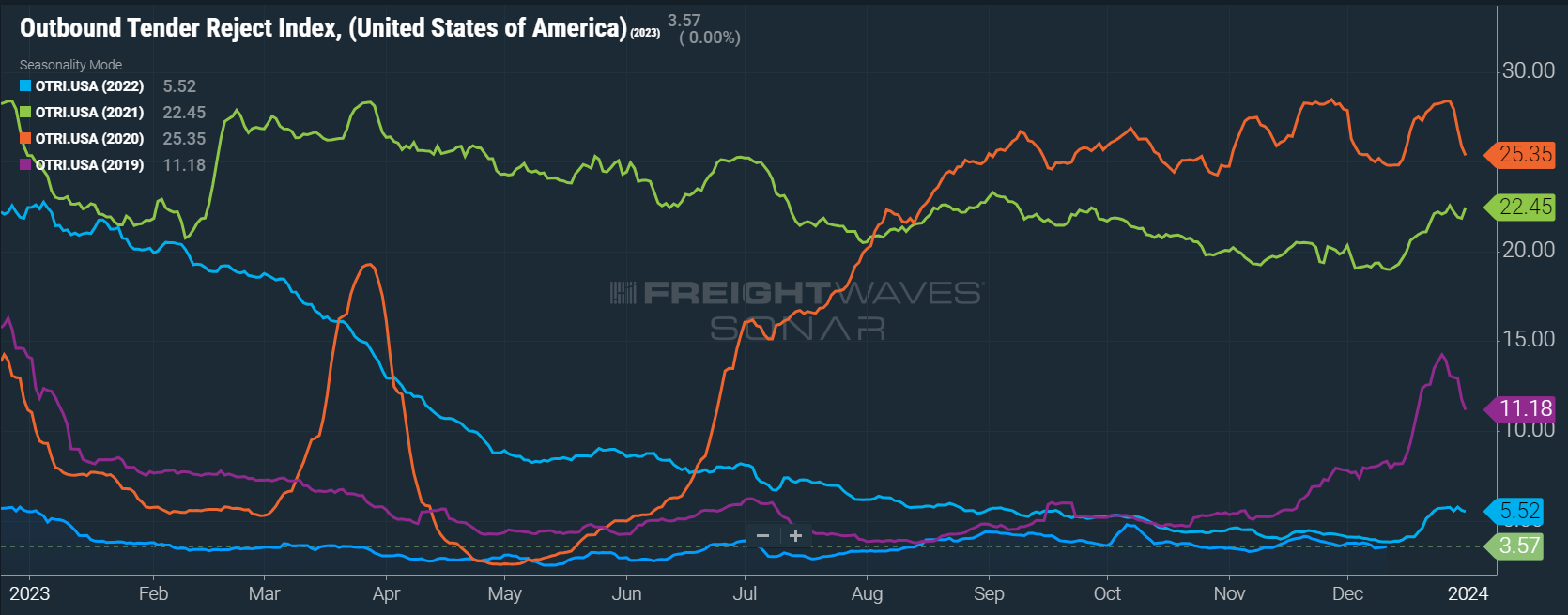
Tender rejections on the Reefer side continue to follow a similar direction as van but with increased volatility. Reefer rejections briefly spiked to 11% ahead of Thanksgiving before declining and ending the month around 7.7%. The current value of 6.87% indicates better routing guide compliance than in November but tighter conditions than in December 2022.
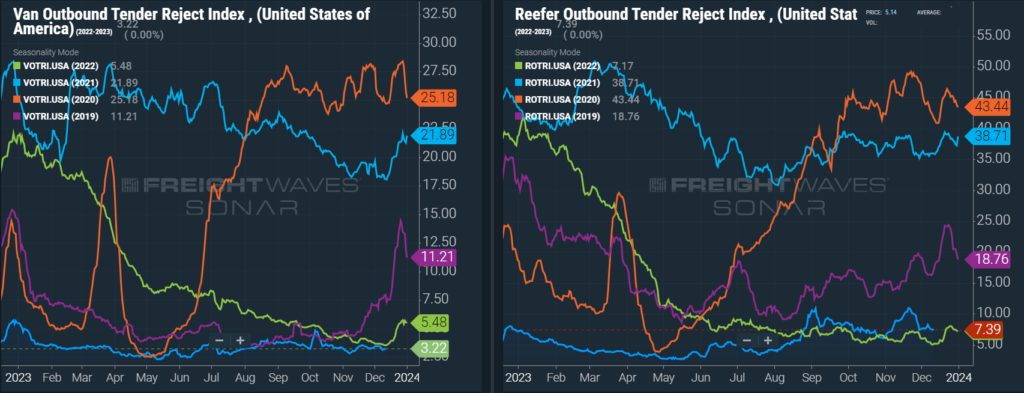
The FreightWaves SONAR Outbound Tender Volume Index (OTVI), which measures contract tender volumes across all modes, was up 9.6% year-over-year, or 10.0% when measuring accepted volumes after the significant tender rejection rate decline.
Accepted volumes were up 11.1% month-over-month as of early December, driven by a 9.9% increase in accepted dry van tenders and a 4.0% increase in accepted reefer tenders. This large jump was relatively unusual for this time of year and can be attributed to flat volumes in October and early November.
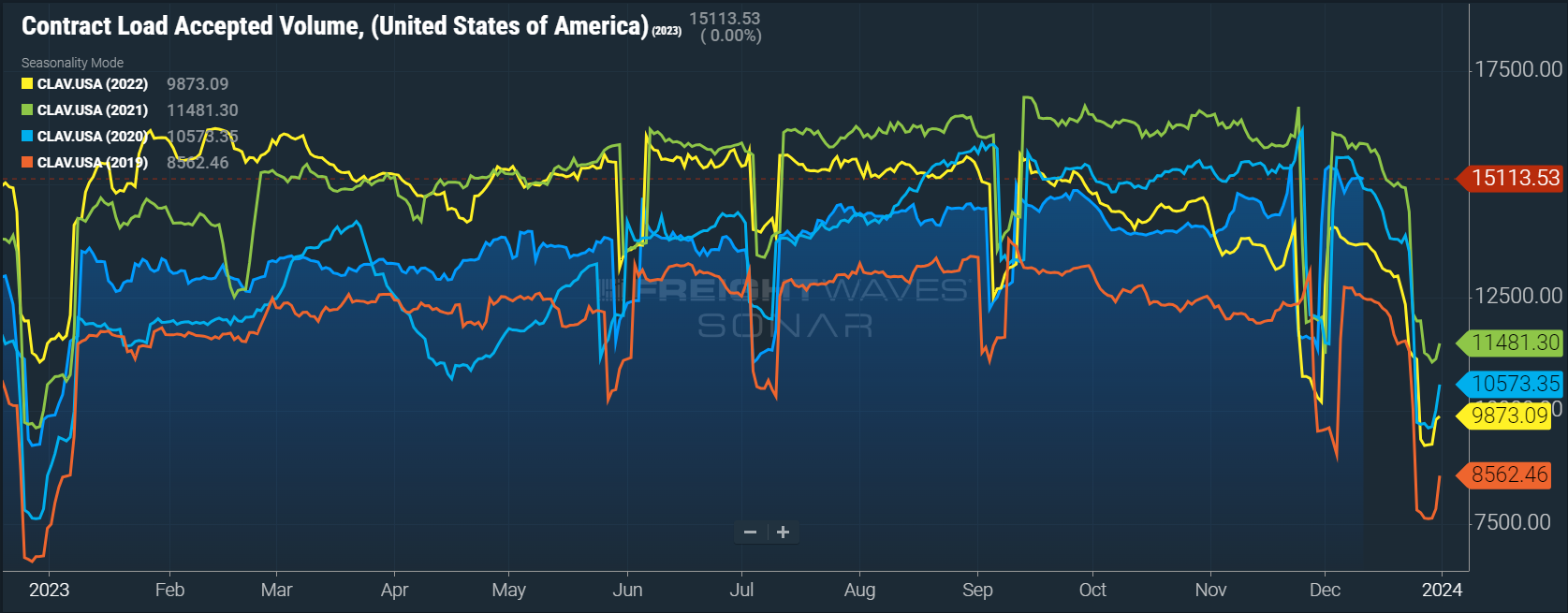
The DAT Load-to-Truck Ratio measures the total number of loads relative to the total number of trucks posted on their spot board. Despite a meaningful spot load decrease, November data showed relatively flat conditions on the van side and increased tightness on the reefer side.
The Dry Van Load-to-Truck Ratio ratio was up 0.2% month-over-month but down 21.2% year-over-year. The Reefer Load-to-Truck Ratio in November was up 7.2% month-over-month but down 36% compared to November 2022. These numbers align with what we experienced throughout the month, with van conditions relatively stable and reefer conditions slightly more volatile.
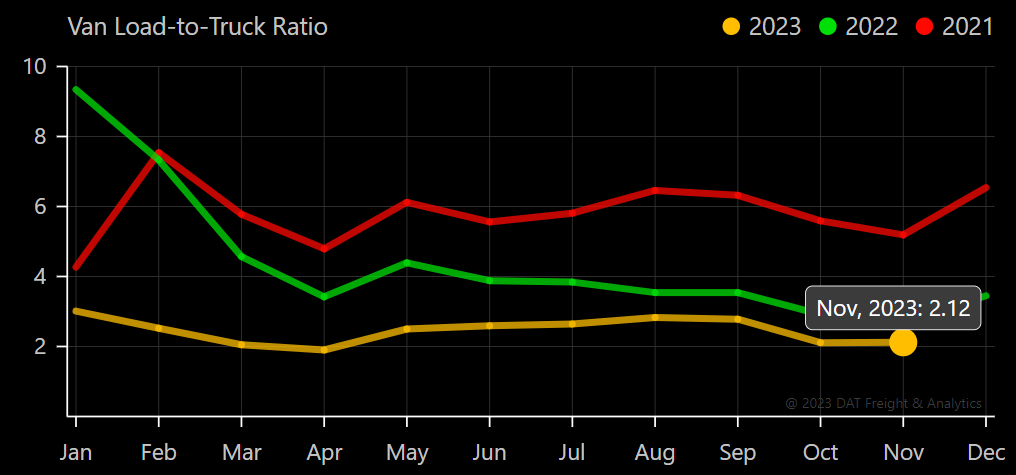
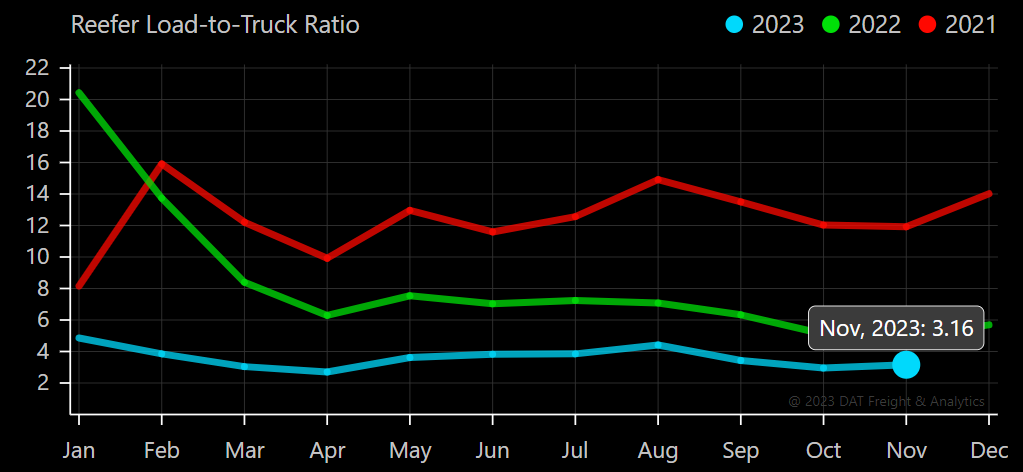
What’s Happening: Capacity continues to exit the market, albeit slower than previous downcycles.
Why It Matters: Persistently slow exits could extend the current market downcycle
Spot rates remain well below where they were at this point a year ago. As a result, carriers with heavy spot exposure continue to see strong margin compression as operating costs stay flat. While recent fuel price declines are providing some relief to carriers, it is not enough to offset the rate drop observed over the past 18 months. Capacity continues to exit the market, but slower than in previous downcycles.
The slow exit rate is largely due to the fact that carriers running mostly contractual freight are still profitable despite market conditions. Smaller carriers and owner-operators are joining larger carriers to avoid complete exposure to the spot market.
Monthly revocations remain below the 2023 peak but well above historical trends. Monthly revocations in November are down from October but above August and September. The high number of revocations led to another month of decline in carrier population, shrinking by over 2,500 carriers.
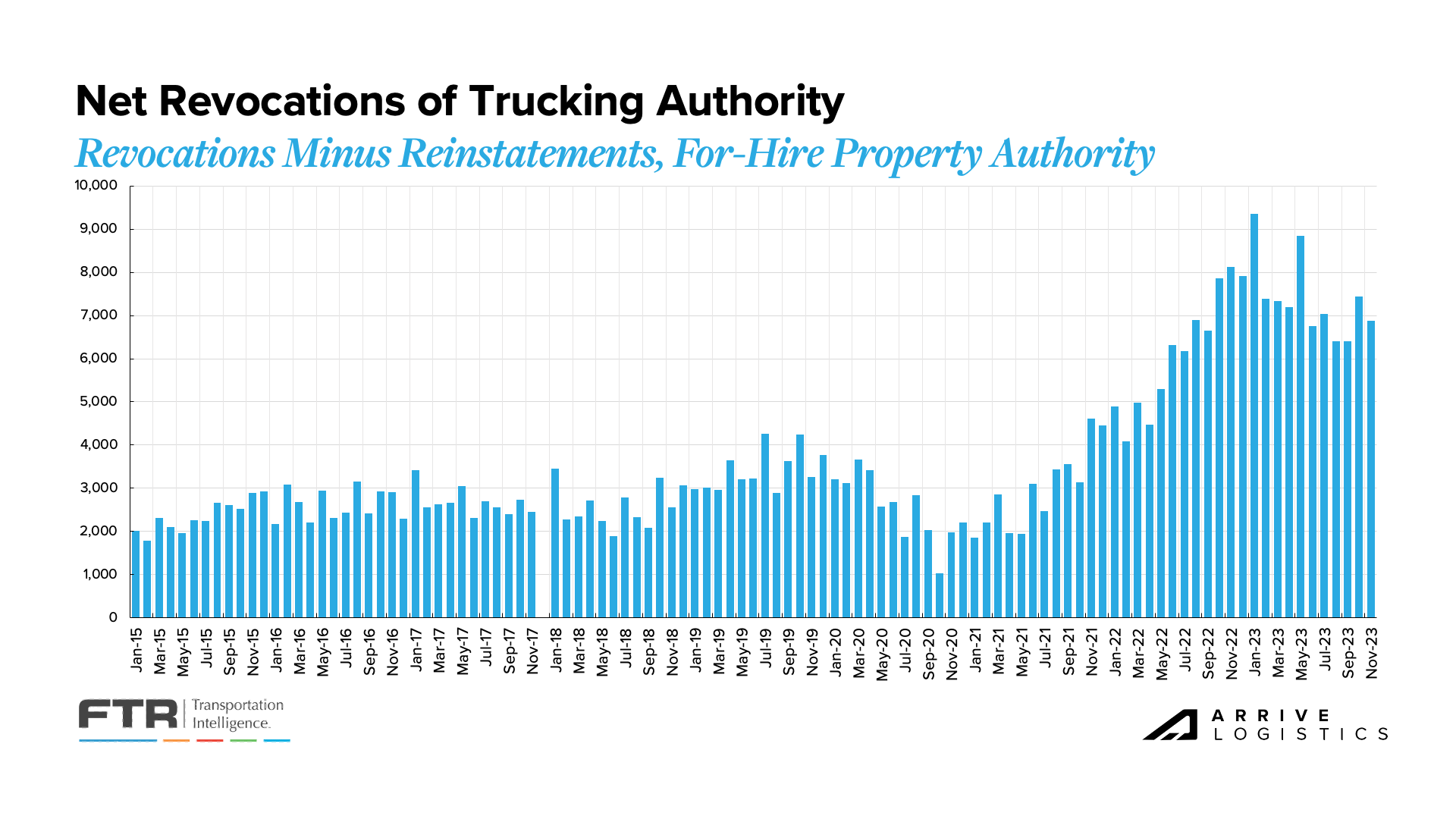
A key trend we’re still watching is revocations outpacing new carriers entering the market for 13 of the last 14 months, reducing the total number of carriers. A significant amount of capacity that entered the market over the last few years remains under-utilized, so we expect this disparity to continue for at least the near term.
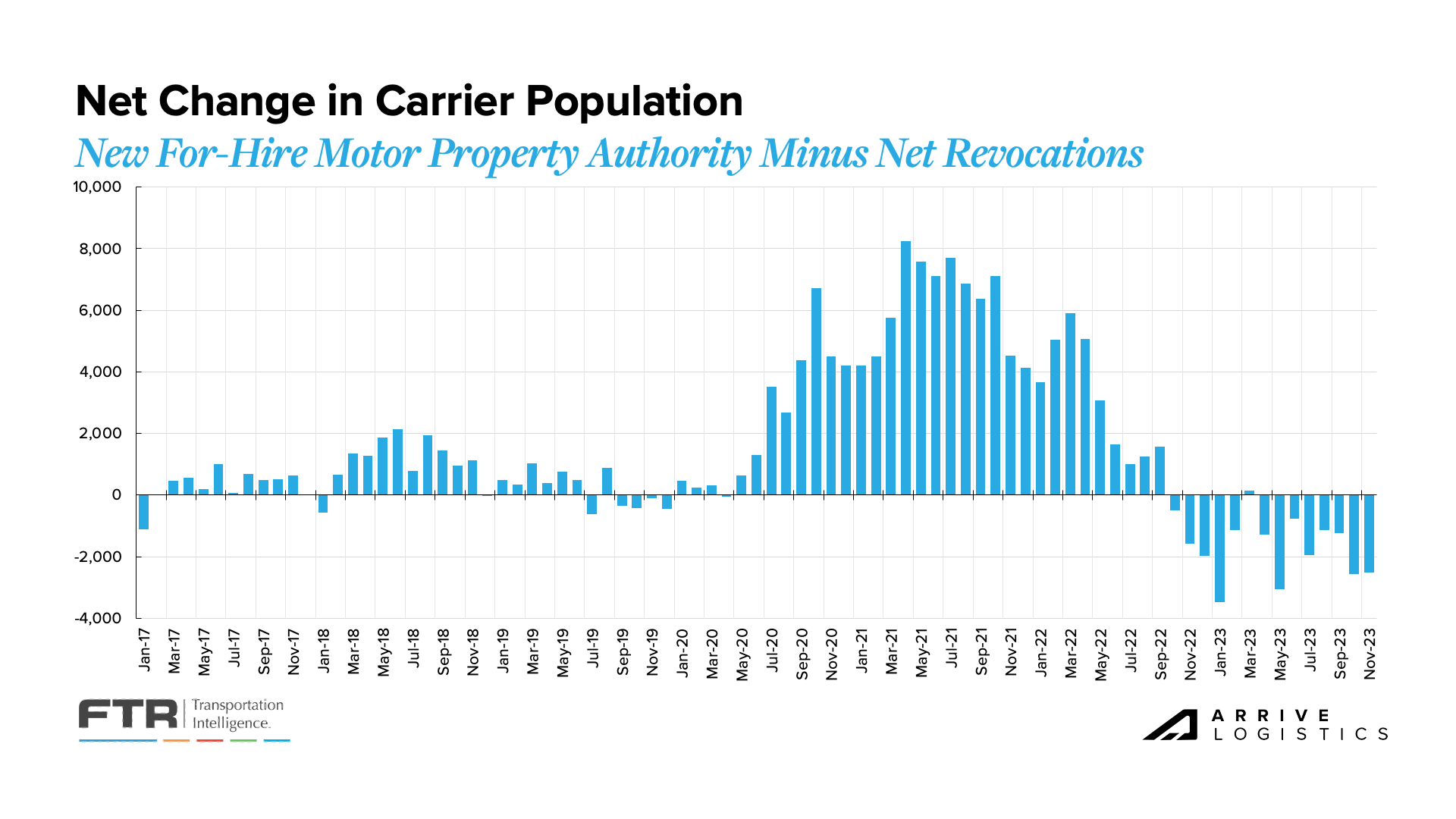
New equipment orders typically slow during freight recessions. However, as OEMs opened up 2024 build slots, carriers moved quickly to secure new orders. The past four months have seen some of the highest order volumes this year, with November’s report of 36,750 orders being the largest in 2023.
This trend likely points to the financial strength of larger carriers and private fleets’ ongoing investment in growth. While order levels were above the historical average, they did align with season trends. The increase in orders also represents the possibility of a much slower capacity reduction than in previous cycles. Overall, freight demand is healthy, so larger fleets are adding capacity to insource volume back from smaller for-hire fleets and owner-operators.
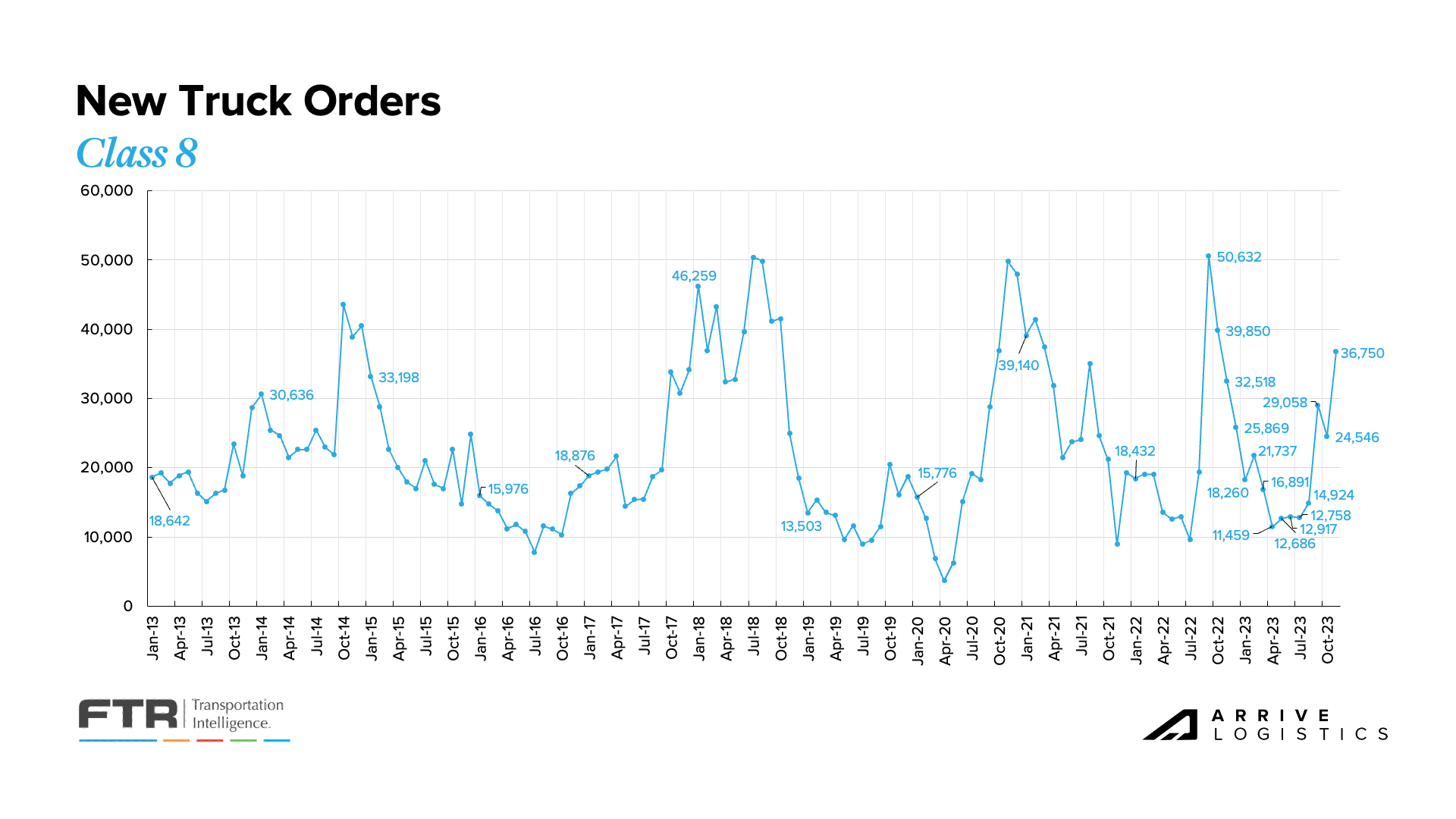
The Class 8 Backlog to Build ratio rose to 5.7 months in November, up from 5.5 months in October. The backlog steadily declined all year until September when it increased by 2,250 units. Backlogs will likely remain relatively flat over the upcoming months as more build slots open and get filled for 2024. A key trend to watch during this period is new truck orders being placed as more build slots open.
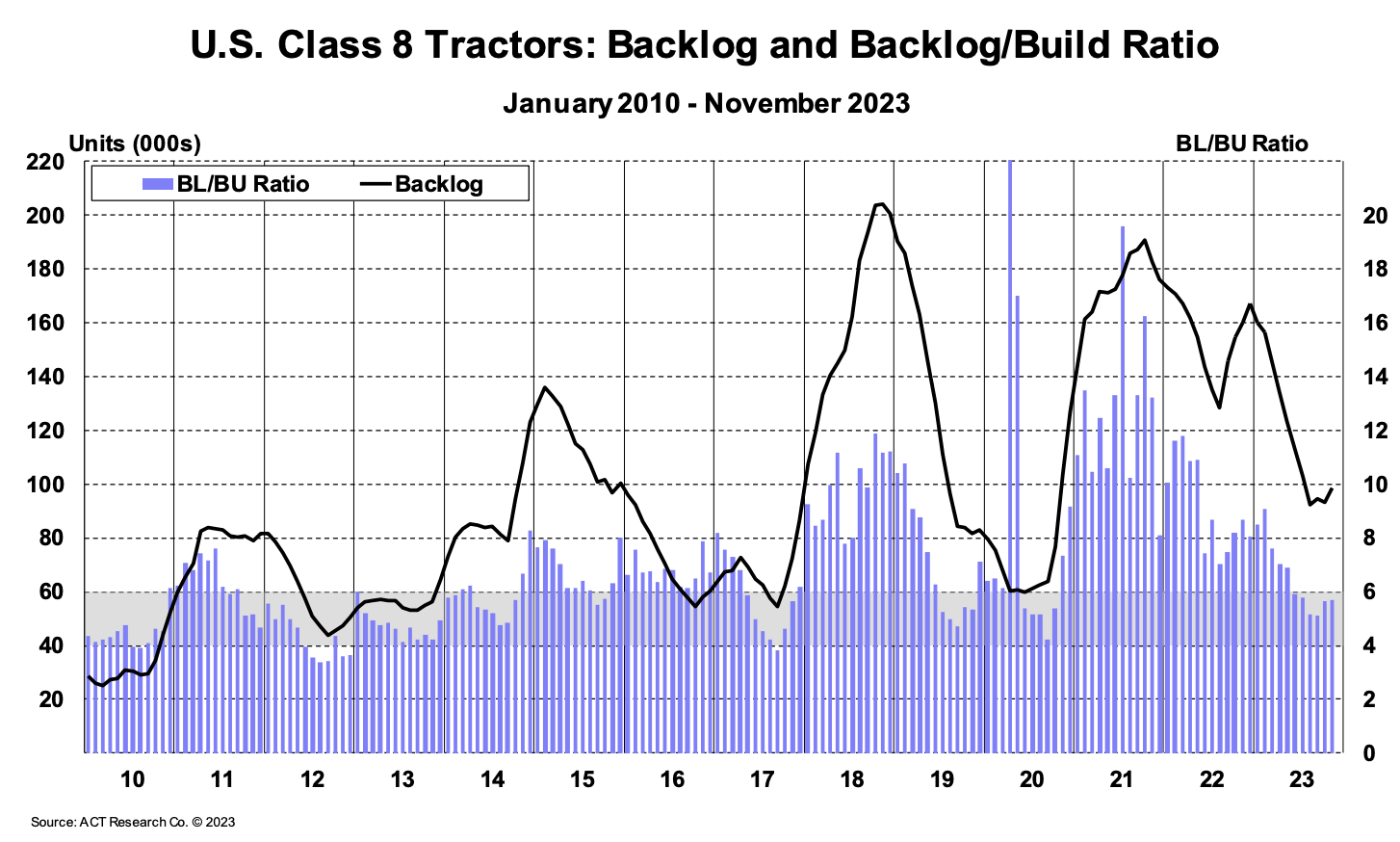
ACT’s Driver Availability Index reached an all-time high of 62 in September before dropping by 6.8 points to 55.2 in October, marking the 17th consecutive month of loosening driver conditions. The primary driver of this trend is likely the influx of owner-operators joining larger fleets that have historically struggled with driver retention. Overarching challenges such as the retiring rate of drivers and FMCSA drug clearance remain prevalent.
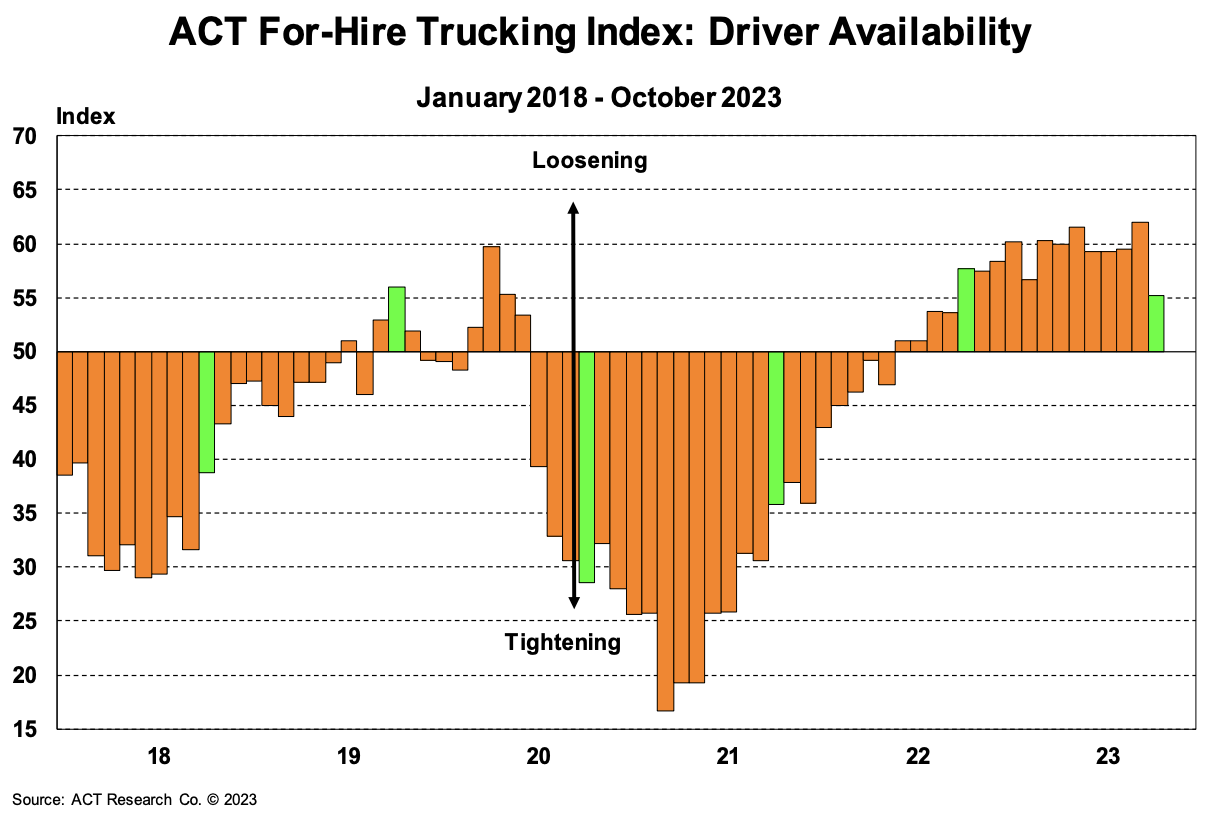
Our October survey asked carriers their opinion on the current truckload supply and what they believe it will be like in three months. 58% of respondents said that supply today is relatively balanced,16% said it is plentiful, and 30% said it’s limited. As for the three-month projections, a few more carriers said capacity will be plentiful compared to now — this is relatively in line with our expectations.
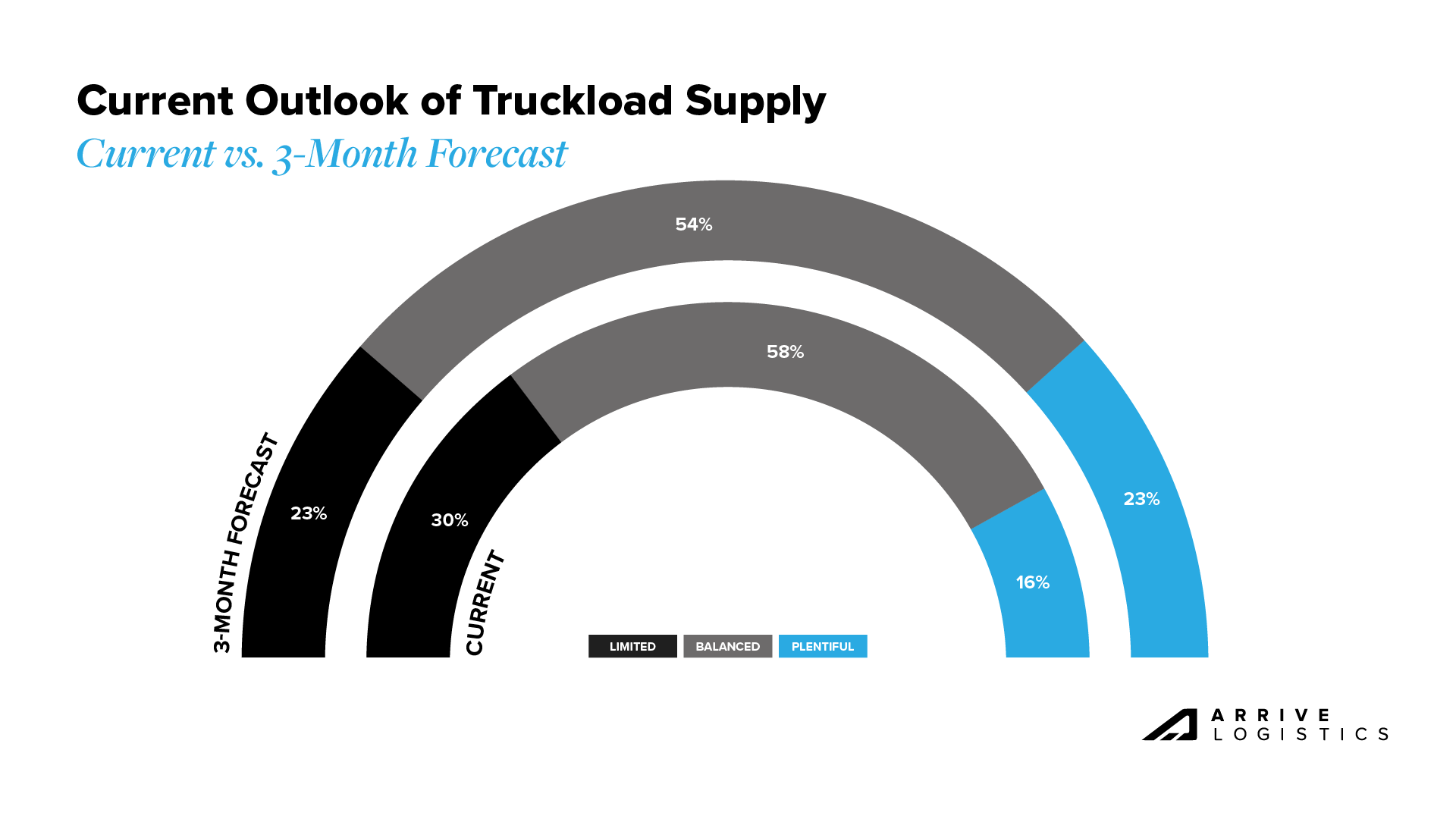
What’s Happening: Demand remains down year-over-year.
Why It Matters: Lack of demand growth is driving rates down.
The survey also prompted carriers about current and future truckload demand. 47% of respondents said demand today is neutral, 32% reported weak demand, and 21% said demand is strong.
In their three-month forecasts, more than half (56%) of all respondents expect balanced conditions, and 26% expect strong demand. This aligns with our forecast that demand will increase through Q4, albeit muted compared to the past few years.

Demand remains down year-over-year and will likely stay flat into early 2024. The overall strength of the consumer remains a focus from an economic perspective. The National Retail Federation (NRF) recently reported that imports peaked in October, which was later than the typical peak expected in August.
Imports in Q4 of 2023 remain above Q4 2022 levels, a sign that retailers may have been completing their destocking phase and were gearing up for the holidays. Downside demand risks remain, including concerns about manufacturing trends, how long strong consumer spending will continue, the potential impact of student loan payment resumption on 2024 housing and construction, and the possibility of an extended period of elevated interest rates.
If import volumes remain in line with the NRF forecast, we will see an 11.5% month-over-month jump in December imports, leading to increased freight movement heading into the last two weeks of 2023 and into early 2024. When all is said and done, the total number of imports in 2023 will be around 22.4 million TEUs, down 12.4% from 2022 and over 13% from the all-time high seen in 2021.
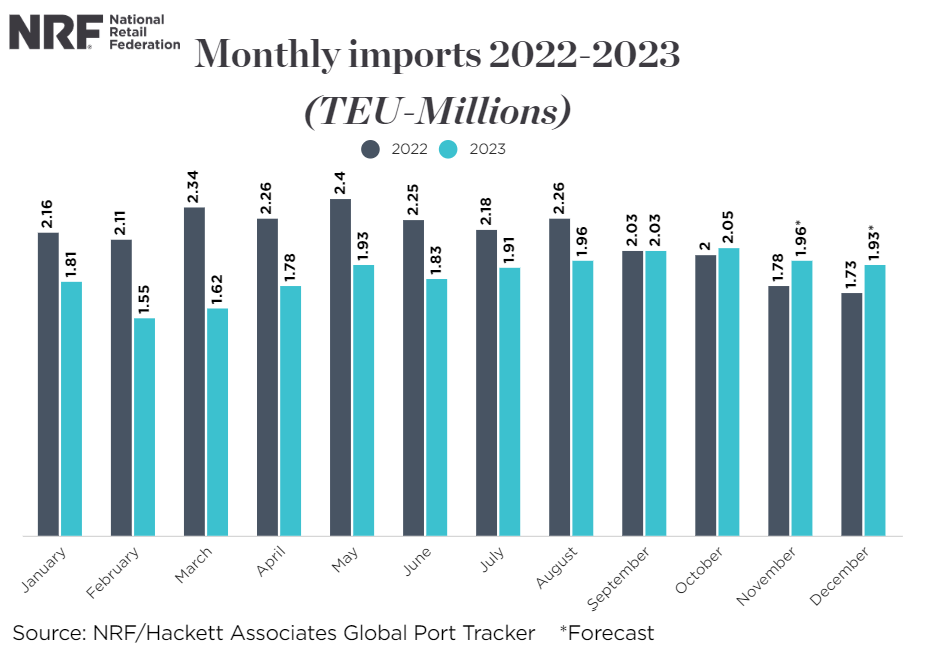
November demand trends continued to reflect the trends that we have been experiencing for the majority of 2023. According to DAT, which reports exclusively on spot load trends, load postings were down 41.3% year-over-year and 12.8% month-over-month. Truck postings also have seen large declines, albeit not as large as the declines we have seen for load postings. Truck postings are down 18.4% year-over-year and declined by 10.9% from October to November.
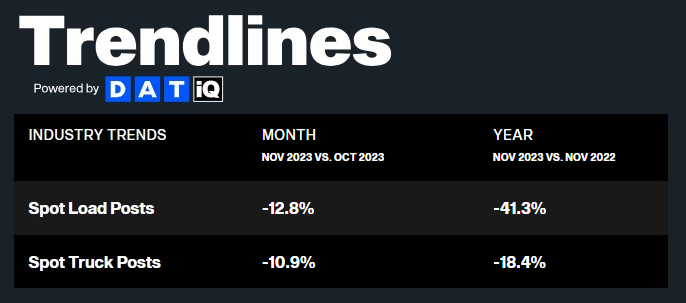
What’s Happening: Carriers with high spot exposure are still seeing negative operating margins.
Why It Matters: These carriers will likely exit the market soon or join larger fleets.
Spot rates are stabilizing but remain well below operating costs for public carriers, which reported negative margins on spot loads for the third consecutive quarter. This trend will likely affect owner-operators and carriers with high spot exposure, potentially leading them to close or join larger fleets. Historically, there would be a rapid rise in spot rates when this occurs. However, capacity is still plentiful, indicating that conditions could remain rough in the near term.
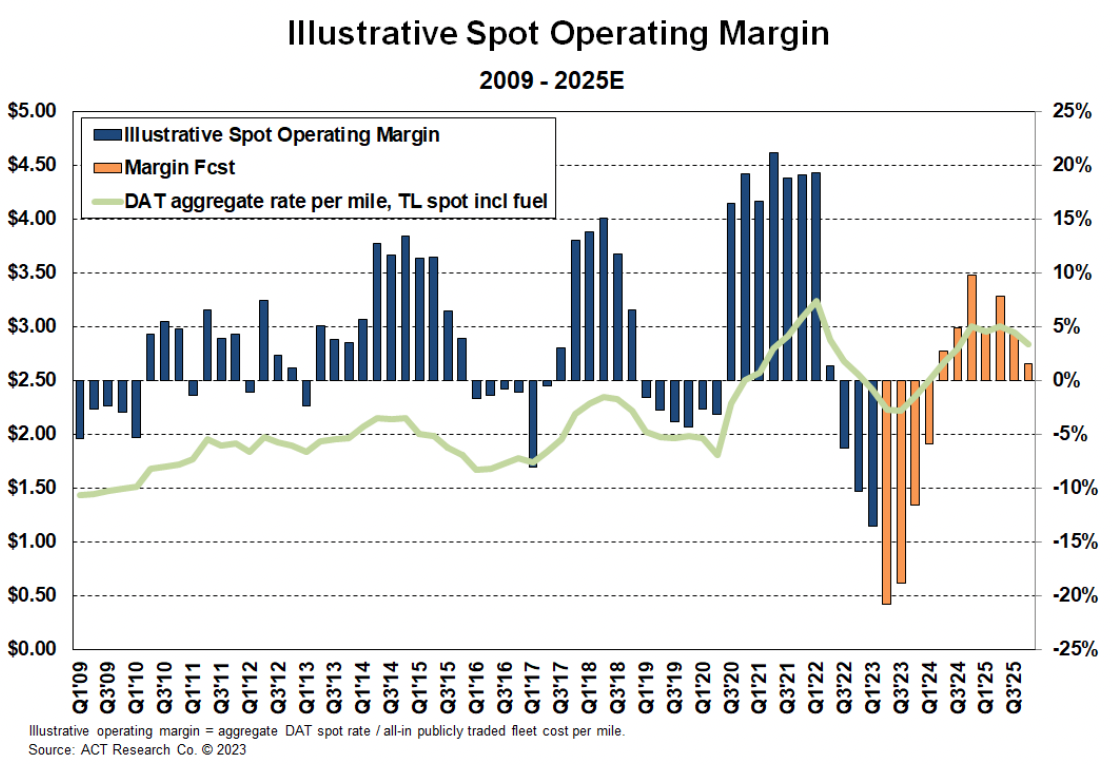
Carriers continue to experience margin compression as spot rates remain low amid high operating expenses. Net income margins in Q3 2023 remained below 5%. Q3 was also the fifth straight quarter where carriers had declining year-over-year margins. As we move through this oversupplied market, conditions will likely stay challenging in the near term and into early 2024.
Figure 22: ACT TL Carrier Database, Net Income Margin, Core Carriers
According to financial data from large public carriers, operating revenue per mile has continued to fall faster than the cost per mile, decreasing operational margins to pre-pandemic levels. Despite the sizeable margin decline, large asset carriers are still in a relatively healthy financial position due to having enough contract freight to limit spot market exposure. On the flip side, owner-operators and smaller fleets are seeing more margin compression and closing or joining larger fleets to stay on the road.
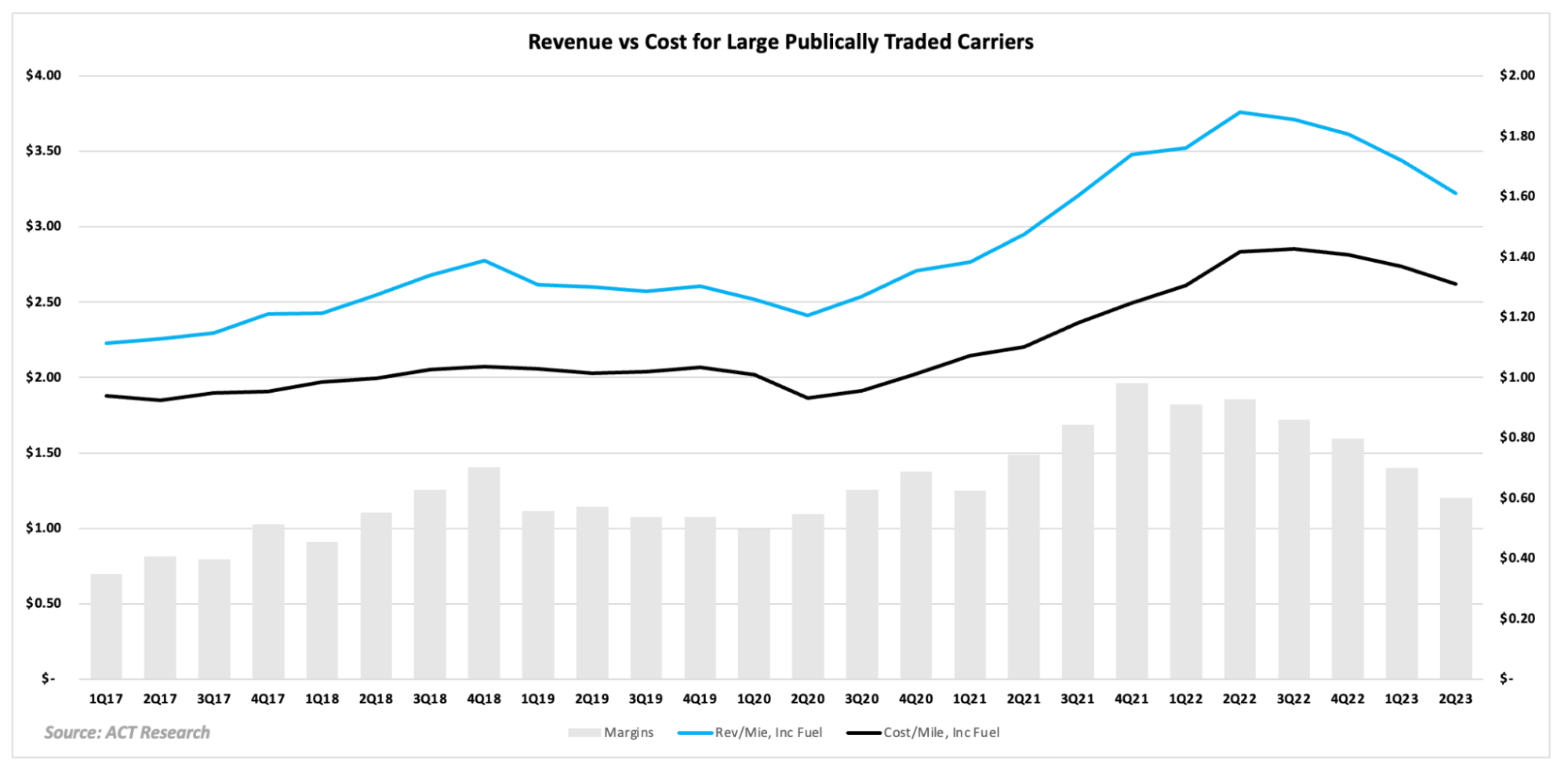
Looking at driver availability survey results, 18% of respondents reported limited driver availability, over half said it was balanced, and nearly a third said it is plentiful today and will still be three months from now. These results confirm our perspective that the market is still oversupplied and indicate carriers believe current conditions will hold for the short-medium term because drivers with access to contract freight remain healthy, and larger fleets continue to take on capacity from smaller fleets and owner-operators.

What’s Happening: Canadian shippers are starting to take holiday time off.
Why it Matters: Less available capacity could lead to higher rates and poor service.
What’s Happening: Cargo theft continues to be prevalent in several regions.
Why It Matters: Insurance rates continue to rise as capacity shifts to safer regions.
What’s Happening: Large LTL players continue to purchase Yellow’s old terminals.
Why It Matters: This demonstrates carriers’ financial stability and appetite for investing in their business.
What’s Happening: The PNW and Midwest are seeing typical seasonal tightness.
Why It Matters: Rates are on the rise in these regions.
East Coast:
Midwest:
South Central:
Southwest:
Pacific Northwest:
What’s Happening: There is a capacity surplus in the open-deck market.
Why It Matters: Rates should stay flat or drop as we enter 2024.
What’s Happening: Rates are seeing increased movement during the holidays.
Why it Matters: Thanksgiving rate volatility will likely be mirrored around Christmas.
The Truckstop’s Weekly National Average Spot Rates index provide a detailed view of week-to-week rate movements and a real-time look into the current rate environment.
Van spot rates remained relatively flat in early November before spiking during the week of Thanksgiving and into December. Reefer rates followed a slightly different trend, increasing in early November before falling toward the end of the month and into mid-December. The flatbed market remained steady, with rates only fluctuating by a couple of cents each week.
Figure 25: Truckstop Weekly National Average Spot Rates
The month-over-month van rate spread decreased by $0.08, dropping from $0.46 in November to $0.38 month-to-date in December.
All-in dry van spot rates are down 12.5% year-over-year in December, while linehaul spot rates are down 9.9%. If rates hold, this would be the second straight month with single-digit percentage declines in linehaul spot rates. Between May 2022 and October 2023, we saw 18 straight months with double-digit percentage declines. All-in dry van contract rates are down 15.9% year-over-year and linehaul contract rates have declined 14.8% year-over-year.
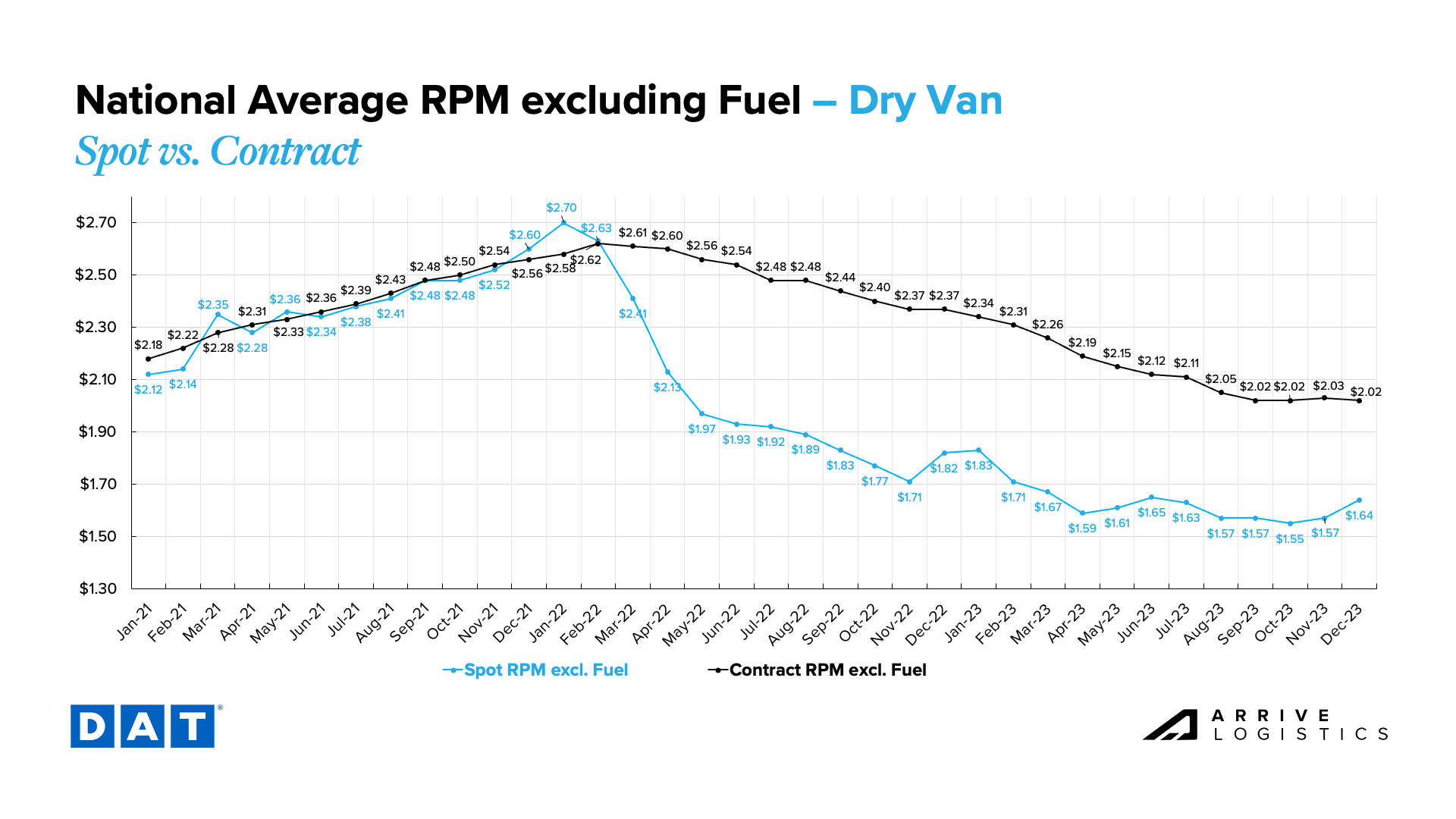
Monthly reefer spot rates rose by $0.07 from October to November but have dropped by $0.03 as of December. Spot rates are currently $1.91, excluding fuel, just $0.04 above the low of $1.87 observed in October.
The reefer spot-contract spread has dropped to $0.39, down from $0.45 last month and the lowest value since April 2022. This is mainly caused by the large contract rate decline this month. As we wrap up the year, expect contract rates to even out and rise slightly above current levels.
The current reefer contract rate has dropped 11.9% year-over-year to $2.30 per mile, excluding fuel. The current reefer spot rate dropped by 12.4% year-over-year to $1.91 per mile, excluding fuel.
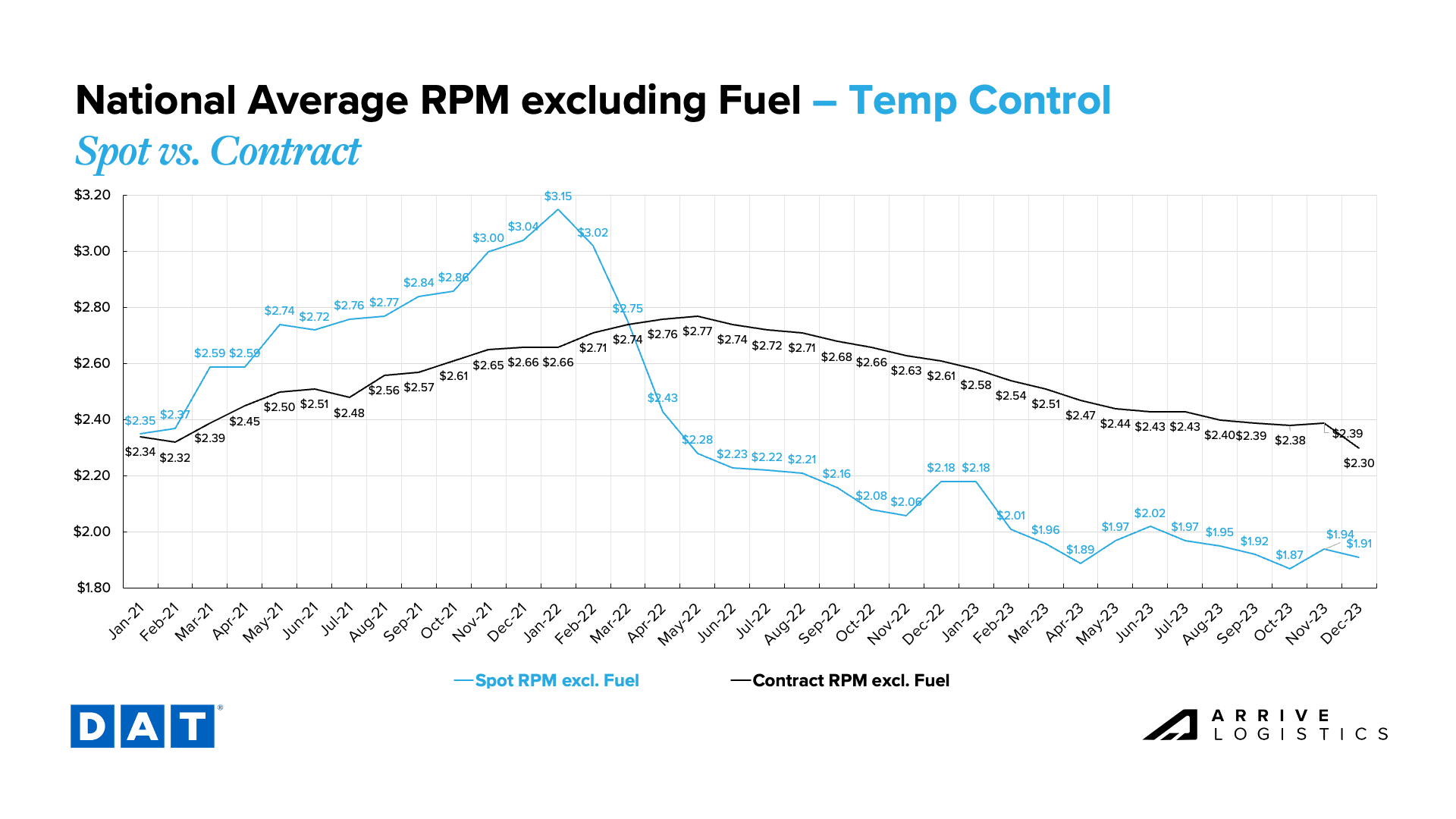
Flatbed spot rates have increased by $0.04 this month, rising to $1.85, excluding fuel. If they hold, it would snap a six-month streak of rate declines. Contract rates have continued to rise, increasing by $0.04 this month to $2.58 per mile, excluding fuel. With both spot and contract rates growing at the same rate, the contract-spot spread remained at $0.73. The last time the spread was higher than this was in November of 2022 when the rate spread was $0.81.
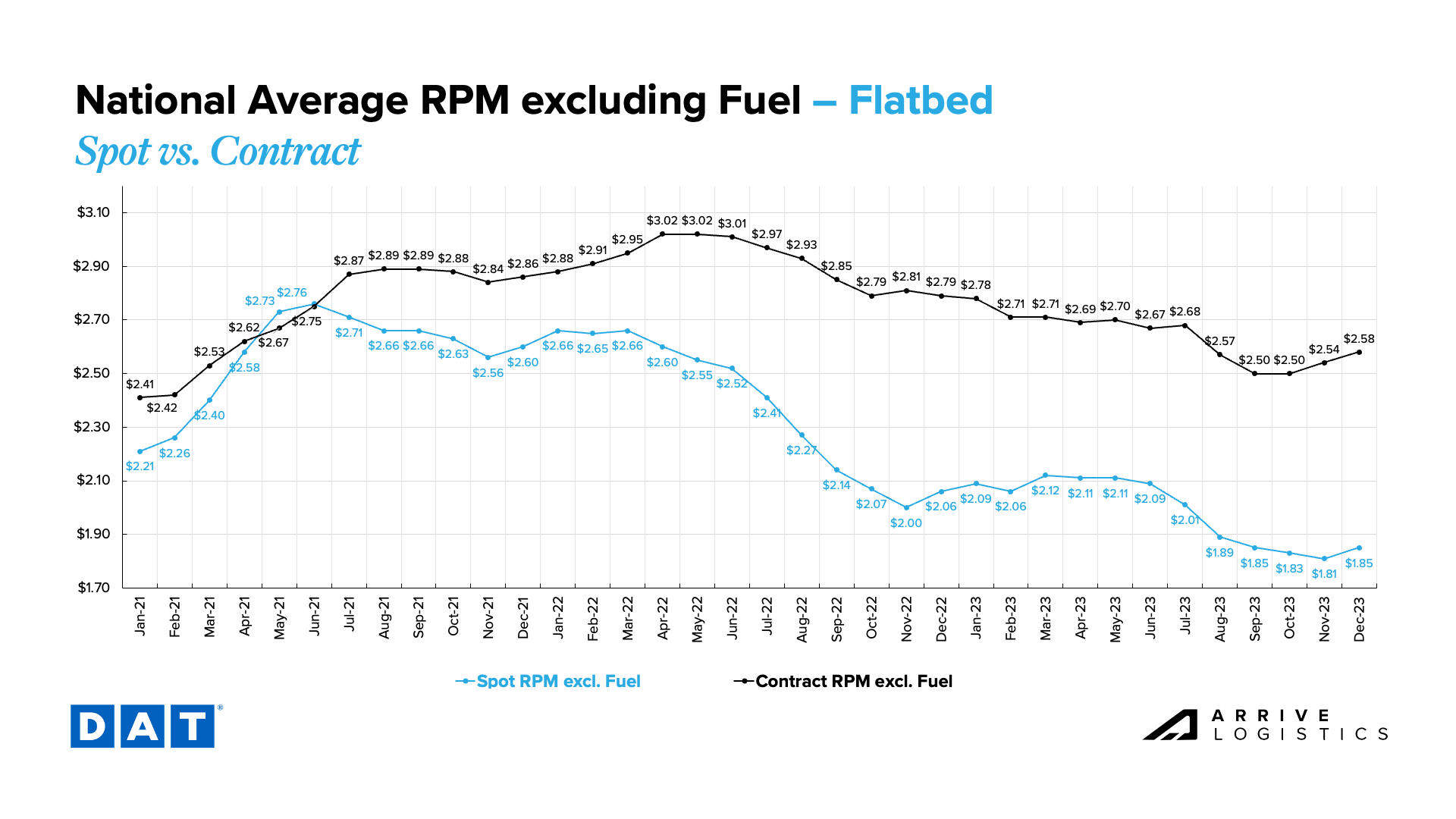
We also asked our carriers what their truckload rates are compared to one year ago. Unsurprisingly, 81% of respondents reported that rates are down year-over-year, while 14% and 5%, respectively, said that rates were flat or higher. This is what we expected, as rates have been in a steady decline for well over a year.
We also asked the same set of carriers what direction they thought rates would go over the next three months. Over half of respondents believe rates will decline throughout the rest of 2023, 21% said they will be flat, and 21% expect rates to rise. These results reflect collective uncertainty about current market conditions and whether we will experience a strong or muted holiday demand push.
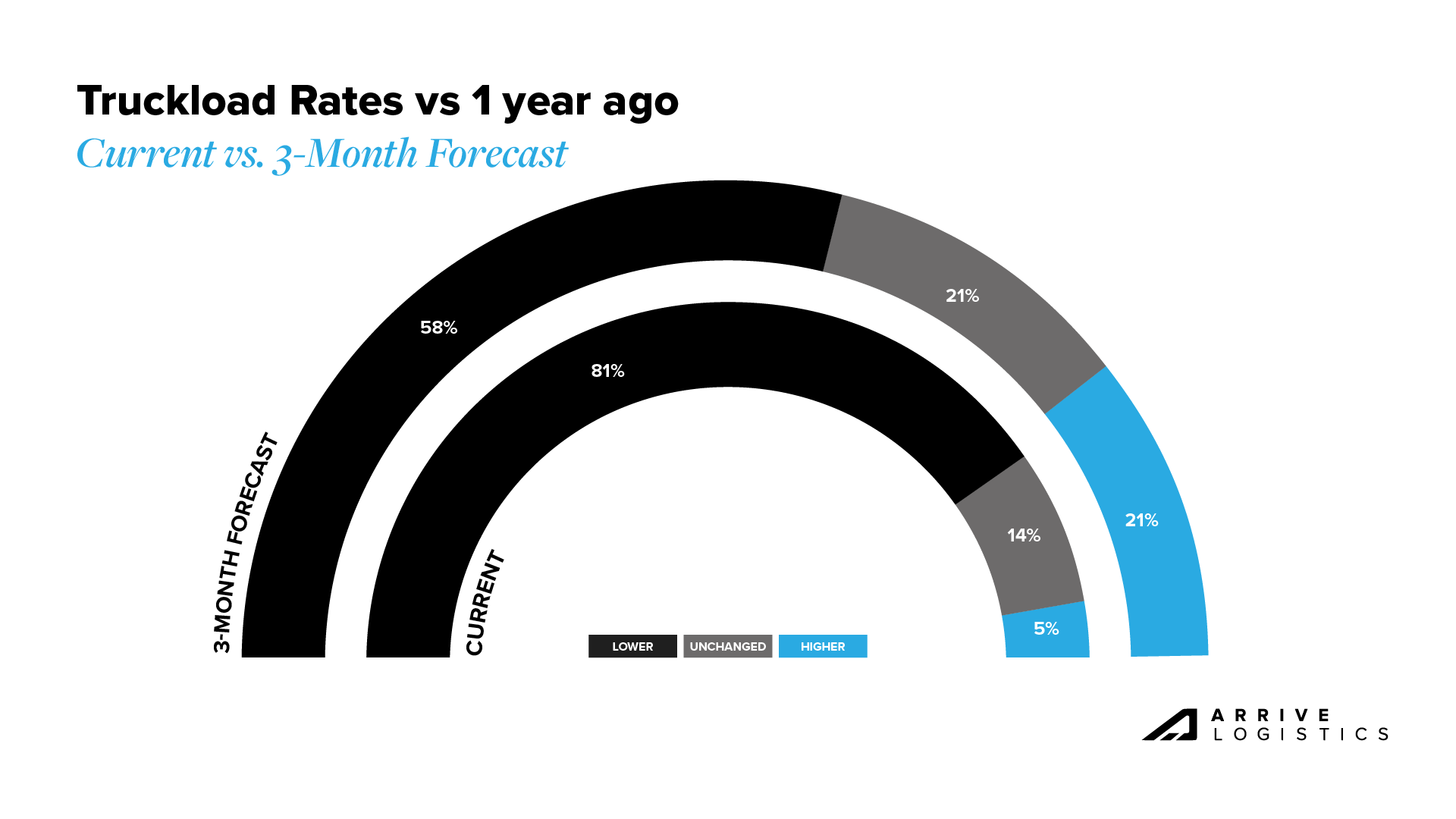
What’s Happening: Inflation continues to cool but remains above the Fed’s target.
Why It Matters: Interest rates will likely remain flat for a few more months, after which we can expect increased consumer activity.
November CPI data showed relatively flat inflation, with the reading up 3.1% year-over-year. As a result, the Fed decided to keep interest rates flat for the third consecutive month. If inflation continues to decline in early 2024, it is possible the Fed will start to lower interest rates at some point in the first half of the year. Lower interest rates would boost housing activity and manufacturing investments — two sectors that have meaningful contributions to freight demand.
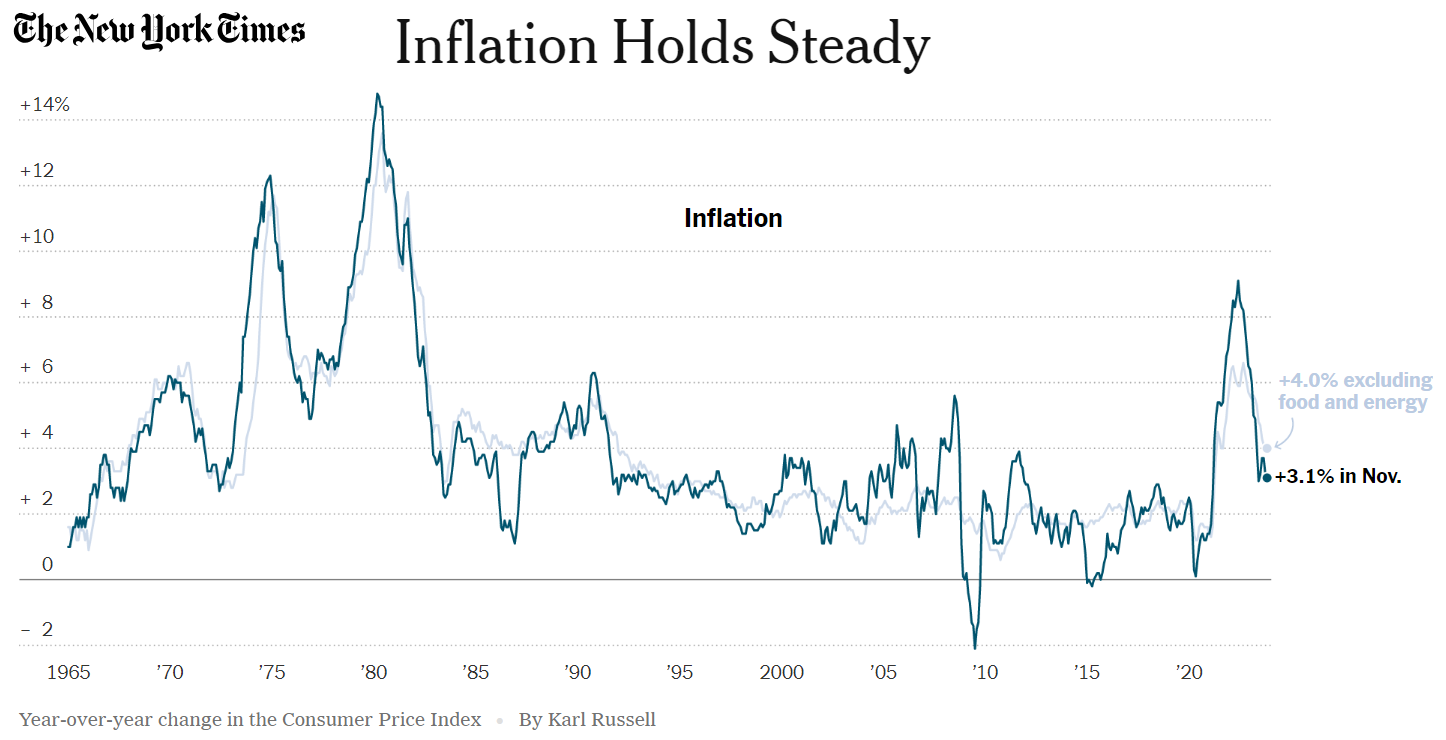
Diesel prices have fallen by $0.65 per gallon since mid-October, providing some relief for carriers. The price decline came despite OPEC+ announcing they would continue cutting oil production in 2024. As demand remains relatively steady, fuel prices will likely level out in early 2024.
Geopolitical events often influence fuel prices. Prices soared soon after Russia invaded Ukraine and took several months to fall. We are now watching the war in the Middle East. While Israel and Palestine are not significant oil providers, the Middle East as a whole has a direct impact on prices in the United States. If the conflict were to affect other regions in the Middle East, we can expect another large fuel price spike.
Figure 31: National Average Diesel Rates & DAT Fuel Surcharge RPM
November Bank of America card data showed consumer spending per household increased by 0.5% year-over-year but decreased by 0.8% month-over-month on a seasonally adjusted basis. This was the largest month-over-month decline observed over the past six months. However, it is important to note that the largest driver was gas spending, which dropped 4% from October due to declining gas prices rather than weak consumer behavior. The only other category to see a decline in spending was groceries, which could also be attributed to declining inflation. The two sectors with the largest growth were furniture and airlines, up 2.9% and 3.0%, respectively.
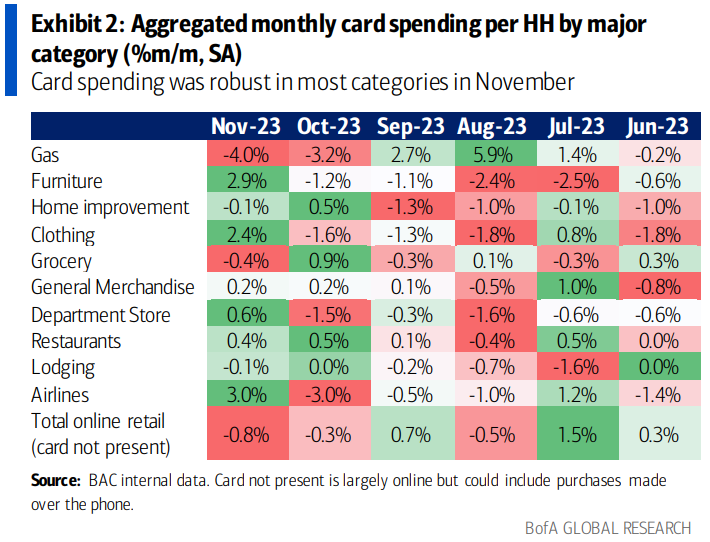
Thus far, end-of-year trends largely mirror what we have experienced for the past 12 months. The market remains oversupplied as carriers with contract freight continue to see profits and invest in their equipment. Nonetheless, we did observe some regional tightness around Thanksgiving, a sign that demand has not completely disappeared.
Our 2024 outlook remains the same. We expect carriers to continue exiting the market during the first few months of the year. In turn, the market will be more vulnerable to disruption, the gap between spot and contract rates will shrink, and spot rates will ultimately increase.
Shippers will likely look to lock in low rates during the next RFP cycle. While there will undoubtedly be some volatility throughout the year, we expect typical seasonality throughout 2024. Q1 freight demand trends should mirror 2023. However, the Fed will likely cut back on interest rates as inflation declines, leading to increased activity in manufacturing, housing and other sectors that drive freight demand.
We continue to monitor the geopolitical conflicts in Ukraine and the Middle East. If either one escalates, they could become “Black Swan” events capable of disrupting the domestic freight market in the U.S.
Ultimately, the freight market will become more vulnerable and move toward an equilibrium state throughout 2024. However, we do not anticipate any significant disruptions in the near term.
The Arrive Carrier Market Outlook, created by Arrive Insights™, is a report that analyzes data from multiple sources, including but not limited to FreightWaves SONAR, DAT, FTR Transportation Intelligence, Morgan Stanley Research, Bank of America Internal Data, ACT Research, Journal of Commerce, Stephens Research, National Retail Federation and FRED Economic Data from the past month as well as year-over-year. We know market data is vital in making real-time business decisions. At Arrive Logistics, we are committed to giving you the data and insights you need to better manage your freight.

